Video of the Week:
Will Fall Mums Last Through the Winter?
Turfgrass:
Apply Late-Season Nitrogen Application in November
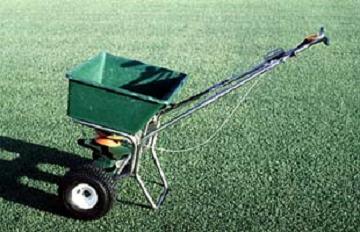
How much should you apply? One to 1 to 1 ½ pounds actual nitrogen per 1,000 sq. ft. of lawn area is sufficient. In order for this application to be effective, the nitrogen must be readily available to the plant, because the growing season is nearly over. Therefore, for a November application, use a soluble (quickly-available) nitrogen carrier such as urea or ammonium sulfate. Many turfgrass fertilizers sold in garden centers and other retail outlets also contain soluble nitrogen. Avoid products that contain water-insoluble nitrogen (slow-release) for this application. As always, sweep up any fertilizer that gets on driveways, sidewalks, or streets and reapply it to the lawn. (Ward Upham)
Tucking your Lawnmower in for the Winter
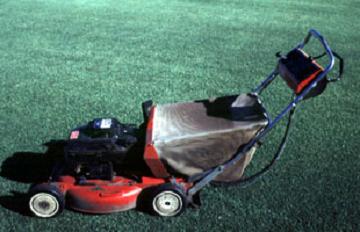
Now is also an excellent time to sharpen mower blades so they'll be ready next spring. Sharpening rotary mower blades is fairly straightforward. The following steps will guide you through this process:
* Check the blade for major damage. If you can't fix it, it likely will need to be replaced.
* Remove grass and debris from the blade with a moist cloth. Dry before beginning to sharpen the cutting edge.
* Remove nicks from the cutting edge, using a grinding wheel or hand-file.
* If using a grinding wheel, match the existing edge angle to the wheel. If hand-filing, file at the same angle as the existing edge.
* Grind or file until the edge is 1/32 inch, about the size of a period.
* Particularly with a grinding wheel, avoid overheating the blade as this may warp it.
* Clean the blade with solvent or oil, much like if you were cleaning a gun, for optimum winter storage. Avoid using water because it will promote rust.
Following these tips can help you better prepare your mower for winter storage and also save you some steps this coming spring. (Ward Upham)
Flowers:
There is Still Time to Plant Spring-Flowering Bulbs
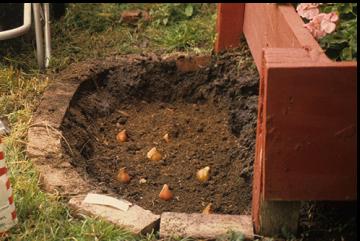
Although many of the best bulbs have probably already been purchased, garden centers may still have a good selection. Be sure to select large, firm bulbs that have not begun to sprout. While many bulbs can adapt to a wide range of soil types, none can tolerate poorly drained soil. Prepare the planting bed by adding organic matter such as peat moss, well-rotted manure, or compost and mix into the soil.
Adequate fertility is essential. It is best to rely on a soil test to determine what nutrients are needed. Garden soils that have been fertilized regularly in the past may have excess levels of phosphorus. Excess phosphorus can interfere with the uptake of other essential micronutrients. In such cases, it would be better to use a fertilizer relatively high in nitrogen such as a 29-5-4, 27-3-3, or something similar. Apply these fertilizers at the rate of 2/3 pound per 100 square feet. Organic sources of fertilizers low in phosphorus include blood meal (12-0-0) applied at 5 to 10 pounds per 100 square feet, cottonseed meal (6-0.4-1.5) applied at the rate of 10 pounds per 100 square feet and soybean meal (7-2-1) applied at the rate of 8 pounds per 100 square feet.
In the absence of a soil test, or if phosphorus is needed, add a low analysis, balanced fertilizer such as 5-10-5 or 6-10-4 at the rate of 2 to 3 pounds per 100 square feet of bed. Mix all amendments thoroughly with the soil before planting the bulbs.
The size and species of the bulb determines how deep to plant. In general, the depth to the bottom of the bulb should be about 2 to 3 times the size of the bulb, but check the planting instructions specific to each particular flower. (Ward Upham)
Perennial Garden Clean-up
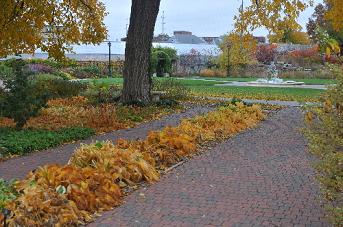
Foliage can be left for other reasons. For example, foliage left on marginally hardy plants such as tender ferns helps ensure overwintering of plant crowns. Also, seed heads on some perennial plants can provide seed for birds. (Ward Upham)
Pests:
Millipede Invasion
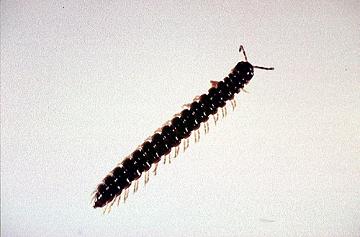
Household invasions are often sudden and sporadic and may be in response to rain. Millipedes feed primarily on decaying organic material, rarely on living tissue. They do not bite people or damage household furnishings directly, but they will leave a mess and give off an odor if crushed.
Millipedes are worm-like and most often brownish-black in color. The legs ripple as they move. Millipedes often curl up into a "C" shape like a watch spring if touched. Remember you may not see the legs unless viewing the millipede from the side. They defend themselves by releasing a disagreeable odor when disturbed.
Millipedes require high moisture to survive and often die in a day or two after entering a house. Dead millipede bodies can then be vacuumed up and disposed of. Drying out moist areas inside will also help with control. Sealing and caulking around openings in the foundation will help keep populations low. If this is not enough, spraying cyfluthrin (Home Pest Control Indoor & Outdoor Insect Killer), proxopur (Baygon), or resmethrin in a three-foot band around the outside of the house will take care of them before they get inside. (Ward Upham)
Hackberry Psyllids Flying Around Homes
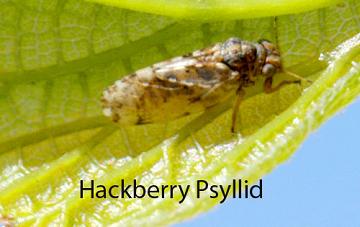
The hackberry psyllid overwinters in the adult stage. These insects are tiny and resemble miniature cicadas. They are dark reddish-brown with mottled wings. Adults are tiny enough that they can crawl through the openings in most screens and therefore often find shelter during the winter inside houses. In the spring, the adults become active about the time the leaf buds of hackberry trees open. The best way to control hackberry psyllids found inside the home is the same as for boxelder bugs: a vacuum cleaner.
Several steps can be taken during the fall just before frost to reduce entry. Turning off outdoor night-lights and reducing the amount of light shining through night windows helps. Consider using fine mesh (18 mesh) screens on windows that are kept open. Ordinary screens are 12 mesh to the inch. Caulk or plug up cracks and crevices. Keep windows and doors closed when psyllids are active. For temporary reduction, spray exterior surfaces such as window screens, shutters and sides of buildings where psyllids are resting. Look for residual insect sprays labeled to use on outdoor surfaces. Examples of ingredients with residual action include cyfluthrin (Tempo, Bayer Vegetable and Garden Insect Spray), bifenthrin (Talstar, Hi-Yield Bug Blaster II), permethrin (numerous trade names), Baygon and tralomethrin. (Ward Upham)
Miscellaneous:
Preserving Garden Tools
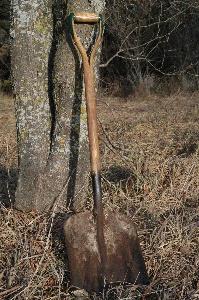
Contributors: Ward Upham, Extension Associate
 RSS Feed
RSS Feed
